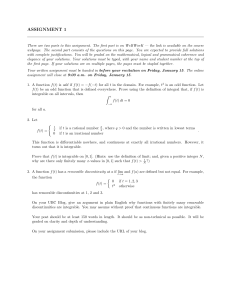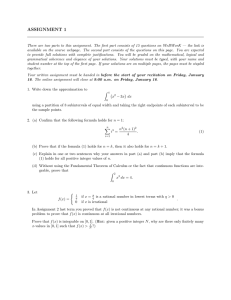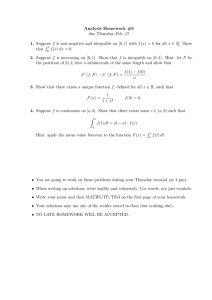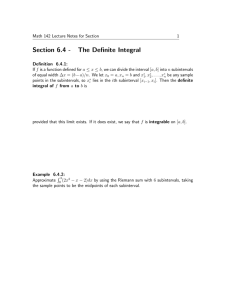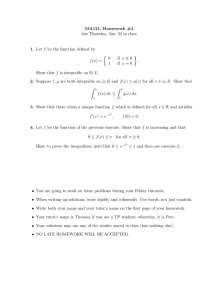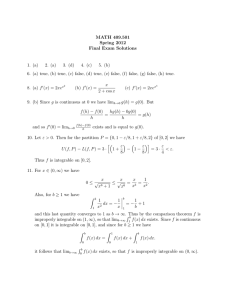ASSIGNMENT 1
advertisement
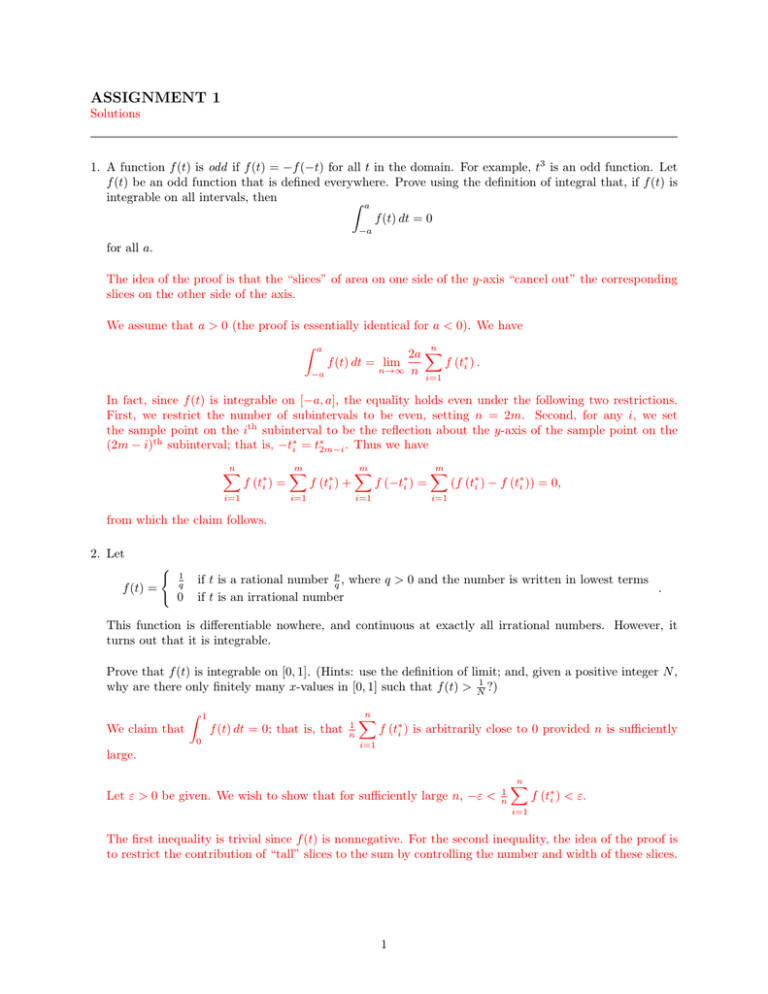
ASSIGNMENT 1 Solutions 1. A function f (t) is odd if f (t) = −f (−t) for all t in the domain. For example, t3 is an odd function. Let f (t) be an odd function that is defined everywhere. Prove using the definition of integral that, if f (t) is integrable on all intervals, then Z a f (t) dt = 0 −a for all a. The idea of the proof is that the “slices” of area on one side of the y-axis “cancel out” the corresponding slices on the other side of the axis. We assume that a > 0 (the proof is essentially identical for a < 0). We have Z n a 2a X f (t∗i ) . n→∞ n i=1 f (t) dt = lim −a In fact, since f (t) is integrable on [−a, a], the equality holds even under the following two restrictions. First, we restrict the number of subintervals to be even, setting n = 2m. Second, for any i, we set the sample point on the ith subinterval to be the reflection about the y-axis of the sample point on the (2m − i)th subinterval; that is, −t∗i = t∗2m−i . Thus we have n X f (t∗i ) i=1 = m X f (t∗i ) + m X i=1 f (−t∗i ) i=1 = m X (f (t∗i ) − f (t∗i )) = 0, i=1 from which the claim follows. 2. Let ( f (t) = if t is a rational number pq , where q > 0 and the number is written in lowest terms . if t is an irrational number 1 q 0 This function is differentiable nowhere, and continuous at exactly all irrational numbers. However, it turns out that it is integrable. Prove that f (t) is integrable on [0, 1]. (Hints: use the definition of limit; and, given a positive integer N , why are there only finitely many x-values in [0, 1] such that f (t) > N1 ?) Z We claim that 1 f (t) dt = 0; that is, that 0 1 n n X f (t∗i ) is arbitrarily close to 0 provided n is sufficiently i=1 large. Let ε > 0 be given. We wish to show that for sufficiently large n, −ε < 1 n n X f (t∗i ) < ε. i=1 The first inequality is trivial since f (t) is nonnegative. For the second inequality, the idea of the proof is to restrict the contribution of “tall” slices to the sum by controlling the number and width of these slices. 1 Let N be a positive integer such that N1 < 2ε . Now there exist only finitely many t-values in [0, 1] such that f (t) > N1 , since t = pq must be such that 0 < p < q < N . Say there exist M such t-values. Then there exist at most 2M subintervals such that f (t∗i ) > N1 for some choice of sample points t∗i ; in all other subintervals, we have f (t∗i ) ≤ N1 < 2ε . Thus n ε 2M 1X ε 1 2M + n = f (t∗i ) < + . n i=1 n 2 n 2 (The first summand in the middle term is from the fact that there are no more than 2M subintervals with 2ε ≤ f (t∗i ) ≤ 1. The second summand is from the fact that for the remaining subintervals, of which there are obviously no more than n, we have f (t∗i ) < 2ε .) By taking n > 4M ε , we guarantee that n 1X f (t∗i ) < ε. n i=1 3. A function f (t) has a removable discontinuity at a if lim and f (a) are defined but not equal. For example, t→a the function 0 if t = 1, 2, 3 f (t) = t2 otherwise has removable discontinuities at 1, 2 and 3. On your UBC Blog, give an argument in plain English why functions with finitely many removable discontinuities are integrable. You may assume without proof that continuous functions are integrable. Your post should be at least 150 words in length. It should be as non-technical as possible. It will be graded on clarity and depth of understanding. On your assignment submission, please include the URL of your blog. 2

